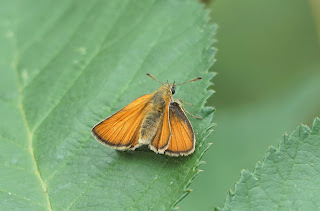I was at the park at lunchtime today to complete the weekly UKBMS butterfly transect and to meet up with a couple of friends for a gentle stroll.
The butterfly count was nice and healthy, although I was expecting a higher Meadow Brown count, but I did get a rather nice extra surprise in the form of a battered Purple Hairstreak. Thank you to Nathalie Mahieu for pointing it out. My first one this year and only my fourth one ever.
So todays tally is as follows....
22/07/20 - 90 minute transect
Essex Skipper x 2 (id confirmed by photos)
Large White x 16
Small White x 5
Small Copper x 11
Holly Blue x 5
Red Admiral x 2
Small Tortoiseshell x 1
Peacock x 1
Speckled Wood x 10
Gatekeeper x 38
Meadow Brown x 9
Purple Hairstreak x 1
I would have expected the Meadow Brown count to be in double figures but I didn't see many at all during todays transect. They tend to be seen more in 'section 5' of my transect route, which starts by the bench at the edge of the scrub corner and goes through the meadow, through the Cattle Paddock and finishes at the gate at the Cranford Lane end of the park. I know during Lockdown this area was very popular with visitors and many, especially the new visitors to the park, did not always stick to the grass pathways. The new cattle didn't arrive until early June. There were a lot of picnics and barbeques in that area during Lockdown, and I'm wondering if the extra foot traffic has affected the Meadow Brown numbers this year. Only by comparing last years figures to next years figures, can I be absolutely certain.
The Small Coppers however, seem to be having a bumper year at Cranford Park and a lot of the ones I saw today were very fresh and new.
The Purple Hairstreak was found, with thanks to Nathalie, in 'section 1' of my route which includes several buddlia just before the Orchard. Purple Hairstreaks usually colonise high up in oaks, and don't often come down low enough to get photos of. They are not rare, just not commonly seen. The individual we saw today looked 'old' but it's more likely that it has had a near miss by a bird meaning it looks a bit ragged and is missing most of it's purple scales.
Here are my photos from today ….
 |
| Peacock |
 |
| Essex Skipper |
 |
| Essex Skipper |
 |
| Meadow Brown |
 |
| Small Copper |
 |
| Small Copper |
 |
| Small Copper |
 |
| Gatekeeper |
 |
| Gatekeeper |
 |
| Speckled Wood |
 |
| Purple Hairstreak - a very battered and 'old looking' individual but still great to see |
We also spotted a Six-spot Burnet, a day flying moth …
and some Cinnabar moth caterpillars ….
As to be expected in mid summer the river is looking particularly 'lush' at the moment. The two photos below are views from both the bridges ….
 |
| View from the stone bridge towards the metal bridge |
 |
| view from the metal bridge towards the stone bridge |
Also spotted on this lovely warm day were this Migrant Hawker and Common Darter ...
And in the Secret Garden we found this beauty. The largest British hoverfly, the Volucella zonaria, the 'hornet mimic' …
The honeybees that have a hive within one of the bricked up arches in the courtyard, were very active today. I haven't seen them this 'busy' so far this year....
During my transect I saw two Kestrels on the grass paths within the Cattle Paddock, but when we went back later we could only see one and he/she didn't want to hang around and be photographed. I also flushed a Skylark by the model aircraft landing strip, and saw a Red Kite over the old oaks. There were lots of Goldfinches calling, and we heard a couple of Green Woodpeckers.
The girls in the Cattle Paddock were as curious as ever ….
We done a bit of litter picking in the Cattle Paddock. Sadly these were full 'dog poo bags'. I appreciate the dog walkers that pick up after their pooches but please take the poop to a bin ! Don't bag it up and leave it, especially within the paddock where the curious cows will try to eat them … bag it and bin it !!!
The only disappointing sight today was all the non-native Himalayan Balsam along the River Crane. This is an annually growing plant that originates from Asia. More about this attractive but invasive plant can be found on this link. One plant can produce 800 seeds and many are spread along rivers, which is why we try to remove any riverbank plants before they set seed. Due to Covid and the Lockdown, we didn't get to do an annual 'Balsam Bashing' day this year, and I did spot a few plants that had spread further from the river bank than in previous years.
 |
| Himalayan Balsam seen from the stone bridge along the river bank |
 |
| Himalayan Balsam flower head |
As well as enjoying a few hours stroll with my good friends Sheila and Nathalie, we also found Ron, Lin, Gary, Martyn, Daphne and Sandra outside the Information Centre, and bumped into Nikki Bates walking Lyns dogs along one of the paths by the side of the meadow. It's always good to have a catch up and chat, and share some banter. Lovely to see everyone, especially Daphne after the sad loss of her David recently.
Beautiful weather and great company. A good all round day

































































